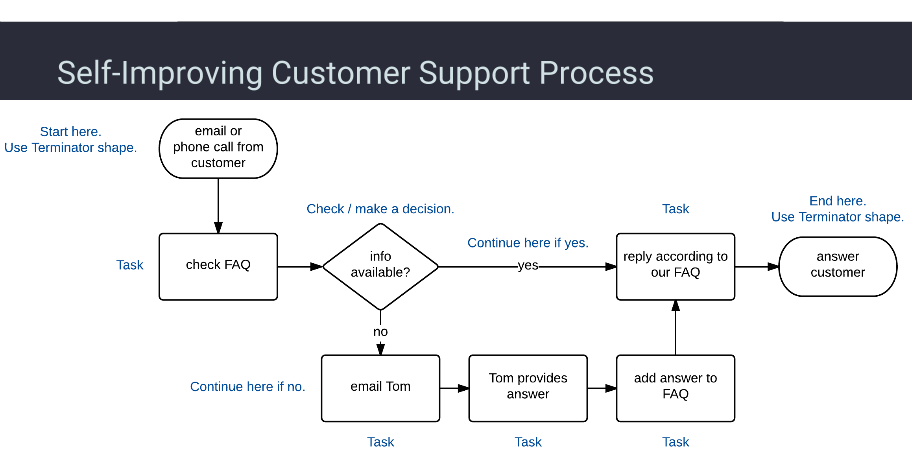Introduction
If a company wants to have a loyal customer base, the managers should be there when something goes terribly wrong. But with the business’s growth and development, providing immaculate customer service all the time can be very expensive and sometimes difficult. On the other hand, there is nothing better that support from an actual human, there is nothing wrong in using content and new technologies for maximizing the use of the available resources. According to the Forbes article written by Adrian Swinscoe, in order for the company to have a successful customer service, it must have a persistent approach and should constantly look for solutions for resolving any issues that arise.
For solving the problems that arise in the customer service environment as well as improving the processes an organization uses, it is very important to understand what is done in the company at every stage. This is where the concept of flow charts comes into play. Flow charts are able to visually present the steps and decisions linked to the business process moreover the format is very easy to understand. Flowcharts are diagrams that visualize the way all processes within the company are integrated with each other. They are used to:
- Defining and analyzing the process in the company.
- Communicating the steps with other employees.
- Standardizing and improving processes.
- Problem troubleshooting.
When it comes to using flowcharts for fixing problems that occur in customer service (Figure 1), it can look something like this:

Case Study
Creating diagrams for solving problems related to responding to customer’s requests makes possible to understand why some processes take much longer that it is considered appropriate by the company. Flowcharts can be useful for identifying the unnecessary process that takes too much time. In addition, they are helpful in figuring out what parties can be affected by changes in the information processing methods.
An angry customer is the worst thing that can happen to the customer service team. Managing customer’s anger can be quite a difficult task that requires time and patience, and, to be frank, the help of diagramming techniques targeted at developing answers to managing angry customers can become very handy. A support employee has received a long email in which the customer only argued about the bad services and poor quality of the product without giving any reasoning. Sometimes such anger from customers is unjustified and is caused by the customer having a rough day. Justified or not, managing customers’ anger should be done in such a way, so both the business and the customer are satisfied.
Thus, the company’s manager has come up with four steps that were arranged in a flowchart are were to be followed by the support team when dealing with angry and stressed customers. The four steps are the following:
Apologize
Even if it is not the company’s fault, saying that you are sorry is the first step when dealing with an angry customer. Moreover, it is advisable to have a view that saying ‘I am deeply sorry about that’ means apologizing that the customer’s experience did not meet the expectations, not that it is the fault of the support team or a separate employee.
Sympathize
A large portion of angry customers is complaining because they want somebody to sympathize them, not because they want the problem fixed immediately. When a support team member does not understand why the customer is so angry for no particular reason, it is best to think about how the employee himself or herself would like to be treated in such situation. Small but powerful responses like ‘I understand how are you feeling’ or ‘This situation would cause distress to anyone,’ can be great in letting the customer know that the support team is working to make things better.
Accept responsibility
As a representative of the company, a support team member should be prepared to accept the responsibility for a problem. This does not mean that the company is responsible or that the customer is able to demand anything at this point, this just gives the client an opportunity to express the feelings without being angry at the company ‘without any face.’ For instance, saying ‘I am very sorry for your disappointment, Mr. Jones, but if you hang in on the line I am personally making sure that your problem will be fixed as soon as possible’, is showing that you care and that you are taking the customer seriously.
Be prepared to help
When dealing with angry customers, fixing the actual problem takes very little time. Placing an order to replace a product or file a refund form will take a couple of minutes compared to the stress of actually trying to calm down an agitated customer. If the employee is working towards the client coming back to the company, it is crucial to take all the above steps targeted at managing conflict. Make sure to spend the majority of time in conversation with the customer and leave them satisfied with the service.